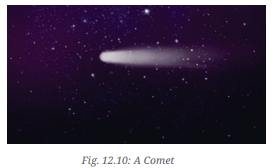Beyond Earth – Complete Guide For Class 6 Science Chapter 12
Welcome to iPrep, your Learning Super App. Our learning resources for the chapter, Beyond Earth in Science for Class 6th are designed to ensure that you grasp this concept with clarity and perfection. Whether you’re studying for an upcoming exam or strengthening your concepts, our engaging animated videos, practice questions and notes offer you the best of integrated learning with interesting explanations and examples.
The chapter Beyond Earth in Class 6 Science takes you on an exciting journey through the mysteries of space. From understanding the night sky, stars, and constellations, to exploring our Solar System and beyond, this chapter opens your eyes to the wonders of the universe. Through engaging examples, fun activities, and detailed explanations, you’ll not only grasp key concepts but also develop a deeper appreciation for the vastness and beauty that exists beyond our planet. Whether you’re a stargazer or simply curious about space, Beyond Earth promises to spark your imagination and curiosity.
Introduction: The Beauty of the Night Sky
In the beautiful region of Nubra, nestled in Ladakh, an eleven-year-old girl, Yangdol, and her twin brother, Dorjay, spend their evenings gazing at the night sky. The lack of air and light pollution makes the stars visible in all their glory. The children are captivated by the stars and the stories told by their elders about how ancient travelers used them for navigation. This chapter explores the wonders beyond our Earth, from the stars and constellations to the vastness of the universe.
Stars and Constellations
As stated in the chapter Beyond Earth, At night, we can see many stars in the sky. Some stars are bright, while others are dim. The stars we see are celestial bodies that emit light of their own. In ancient times, people used to observe the stars carefully, and they noticed that certain groups of stars appeared to form patterns or shapes. These shapes reminded them of animals, characters, and objects, which they referred to as constellations.

The figure describes various constellations, focusing on Orion, Canis Major, and Taurus. Orion is depicted as a hunter, recognizable by the three stars forming his belt. Canis Major, representing Orion’s dog, contains Sirius, the brightest star in the night sky. In Indian astronomy, the term nakṣhatra refers to individual stars or groups of stars, with examples like Betelgeuse (associated with Orion and called Ārdrā) and Aldebaran (in Taurus, known as Rohiṇī). The Pleiades cluster in Taurus is referred to as Kṛittikā. The accompanying figure illustrates these constellations and stars with imaginary lines for easier identification, though these lines are not visible in the actual night sky.
There are two-star patterns: the Big Dipper and the Little Dipper. The Pole Star (Polaris), part of the Little Dipper, is noted for its stationary position in the North, making it useful for navigation in the Northern Hemisphere. The Big Dipper belongs to the constellation Ursa Major, while the Little Dipper is part of Ursa Minor. In India, the Big Dipper is referred to as Saptaṛiṣhi, and the Pole Star is called Dhruva tārā.
Additionally, various forest-dwelling communities and tribes in India have unique stories associated with these constellations. For instance, tribes in Central India see the four stars of the Big Dipper as a “grandmother’s cot,” with the other three stars representing thieves stealing it. Fishermen along the Konkan coast visualize the four stars as a boat, with the last three stars representing the neck of the
Activity: Let’s Draw Our Constellation
- Look at the stars in the sky and try to imagine a pattern.
- Draw lines to connect the stars and form a recognizable shape.
- Name the pattern after an animal or object that you think it resembles.
The Importance of Constellations
According to the chapter Beyond Earth, Constellations were important in the olden days, especially for navigation. Sailors and travelers used them to find directions, long before compasses and GPS technology existed. Today, the night sky is divided into 88 official constellations by the International Astronomical Union (IAU), which helps us easily identify different regions of the sky.
Night Sky Watching
The night sky offers a magical view, especially in areas with little light pollution, like Nubra. In big cities, smoke, dust, and artificial lights make it harder to see stars clearly. However, in villages or remote places, the night sky appears much clearer.
Light Pollution: Excessive artificial light at night makes it difficult to observe celestial objects like stars and constellations. Dark sky reserves and parks have been established in some parts of the world to preserve the natural beauty of the night sky for research and sky-watching.
Preparation for Night Sky Watching
To fully appreciate the beauty of the night sky beyond earth, choose a dark and open area, away from lights and tall buildings. For the best experience:
- Select a moonless night with no clouds.
- Carry a sky map or use a mobile app like Sky Map or Stellarium to help identify stars and constellations.
- Wait for about 30 minutes to allow your eyes to adjust to the darkness.
Once your eyes are adjusted, you can easily identify constellations like the Big Dipper, Little Dipper, and the Pole Star.
Our Solar System
As mentioned in the chapter Beyond Earth, Solar System is a vast collection of celestial bodies orbiting the Sun, including planets, moons, asteroids, and comets.
- The Sun: The Sun is a massive, glowing ball of gases and the closest star to Earth. It provides heat and light, making life possible on our planet. The Sun’s energy supports the growth of plants, creates weather patterns, and drives the water cycle.
- The distance between the Earth and the Sun is approximately 150 million kilometers, a measurement known as an astronomical unit (AU). There are many more objects in the sky. Our Earth, along with some of these objects, and the Sun together form our Solar System. Most of these objects move around the Sun. The movement of an object around the Sun is called a revolution.
Now let’s move forward in the chapter Beyond Earth and learn about the eight planets of the solar system.
The Eight Planets of the Solar System
The chapter Beyond Earth further explains that In order of their distance from the Sun, the eight planets are:
- Mercury
- Venus
- Earth
- Mars
- Jupiter
- Saturn
- Uranus
- Neptune
- Inner Planets: The first four planets—Mercury, Venus, Earth, and Mars—are smaller and have solid surfaces.
- Outer Planets: The outer planets—Jupiter, Saturn, Uranus, and Neptune—are gas giants with ring structures.

There are various planets in our solar system beyond Earth, highlighting their unique characteristics. Venus, known as the Morning Star or Evening Star, shines brightly at dawn and dusk. Mars is referred to as the Red Planet due to its reddish soil, while Earth, covered largely by water, is called the Blue Planet. The four outermost planets—Jupiter, Saturn, Uranus, and Neptune—are giant gaseous planets with large ring structures composed of dust and rocky material.
Planets primarily receive energy from the Sun, which influences their temperatures; generally, the farther a planet is from the Sun, the colder it is. However, Venus is hotter than Mercury due to its thick atmosphere, which traps heat.
Pluto, once considered the ninth planet, is now classified as a dwarf planet by the International Astronomical Union (IAU) due to its smaller size compared to other celestial bodies.
In terms of visibility, Venus is the brightest object in the sky after the Sun and the Moon, followed by Mercury, Mars, Jupiter, and Saturn, which can also be seen without a telescope. Unlike planets, stars appear to twinkle, helping to distinguish them from planets.
Planets and Moons
As per the chapter Beyond Earth, Each planet in the Solar System has unique characteristics:
- Earth is called the Blue Planet due to its vast oceans, and it has one natural satellite, the Moon.
- Mars, known as the Red Planet, has a reddish appearance due to its iron-rich soil.
- Venus is often visible as the Morning Star or Evening Star, though it is not a star.
Some planets, such as Jupiter and Saturn, have multiple moons, while smaller objects like Pluto are classified as dwarf planets due to their size.
Natural Satellites
Objects that move around planets are commonly called satellites. They are smaller in size than planets. Moons are natural satellites of planets. The Earth has one Moon, while Mars has two moons. Jupiter, Saturn, Uranus, and Neptune have a large number of moons.
The Moon
The Moon, Earth’s natural satellite, revolves around Earth in about 27 days. Its surface is marked by craters, formed by the impact of asteroids. India’s Chandrayaan missions have contributed significantly to our understanding of the Moon, with Chandrayaan-3 achieving a historic landing near the Moon’s south pole in 2023.

Asteroids and Comets
When going beyond earth we ca observe that. the Solar System also contains many smaller objects, such as asteroids and comets.
- Asteroids: These are rocky, irregularly shaped objects found mainly in the asteroid belt between Mars and Jupiter.
- Comets: Comets are icy, rocky bodies that develop glowing tails as they approach the Sun. One of the most famous comets is Halley’s Comet, which appears every 76 years.

The Milky Way Galaxy
On clear, moonless nights, you can see the Milky Way Galaxy as a faint band of light stretching across the sky. This galaxy, also called Ākāśha Gangā, is our home and contains billions of stars, including our Sun. Our Solar System is just a tiny part of this massive galaxy.
The Universe Beyond
Beyond earth and even beyond the Milky Way, there are countless other galaxies in the vast universe. Scientists are constantly studying these distant galaxies to understand more about the nature of stars, planets, and the possibility of life beyond Earth. While no evidence of life has been found on other planets, the search continues, particularly on exoplanets, planets that orbit stars outside our Solar System.
Conclusion: The Wonders of the Universe
The night sky holds many wonders, from the stars and constellations that guided ancient travelers to the planets and moons of our Solar System. With modern technology like telescopes and space missions, we are constantly learning more about the universe beyond Earth. Whether observing constellations or exploring planets, the universe continues to inspire curiosity and wonder in young explorers like Yangdol and Dorjay.
In conclusion, the vast universe beyond Earth offers endless opportunities for exploration and discovery. From the stars that form beautiful constellations to the intricate details of our Solar System, this chapter has taken you on an incredible journey through the wonders of the cosmos. As you delve deeper into CBSE Class 6 Science Chapter 12, Beyond Earth, you’ll find that there is always more to learn, observe, and appreciate about the universe. Keep exploring the resources on iPrep Learning Super App to fully grasp the concepts of Beyond Earth and ace your understanding of this fascinating chapter!
Practice questions on Chapter 12 - Beyond Earth
Get your free Chapter 12 - Beyond Earth practice quiz of 20+ questions & detailed solutions
Practice Now








